 |
|
This nurse shark was found hiding under a ledge in the shallow part of El Cedral Reef. Like most sharks, nurse sharks are shy and usually hide or swim away from divers. The little barbels on its mouth may help the shark find prey under the sand. (Photo by Cindy LaRosa) |
 |
 |
|
A sea turtle swims to the surface to get a breath of air. Although excellent breath holders that can survive for a long time underwater, they must still occassionally return to the surface to breath. They usually only take one quick breath and then immediately return to the bottom. (Photo by Cindy LaRosa) |
 |
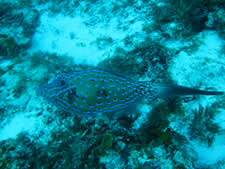 |
|
A scrawled filefish swims along Yucab Reef on the second dive on Tuesday. (Photo by Cindy LaRosa) |
 |
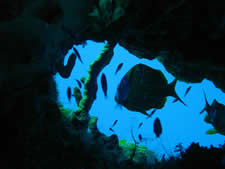 |
|
A view through a hole in Yucab Reef, silhouetting the large amount of life on this shallow reef with lots of nooks and crannies. (Photo by Cindy LaRosa) |
 |
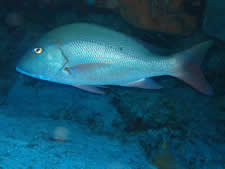 |
|
A mutton snapper hides under a ledge. (Photo by Cindy LaRosa) |
 |
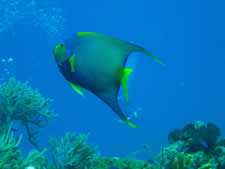 |
|
A queen angelfish lifts off the reef. Kevin can be seen watching in the distant background. (Photo by Cindy LaRosa) |
 |
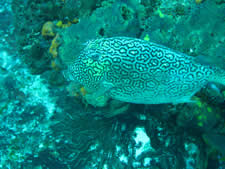 |
|
An odd-shaped but colorful honeycomb cowfish swims past. The horns over its eye distinguish cowfish from the similar looking trunkfish, which have no horns. (Photo by Cindy LaRosa) |
 |
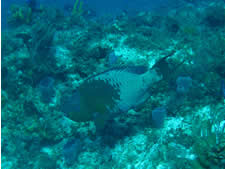 |
|
A large rainbow parrotfish swims past. There were quite a few large parrotfish seen, which is a good sign of a healthy reef. They are rare in areas of heavy spearfishing since they are considered good eating. (Photo by Cindy LaRosa) |
 |
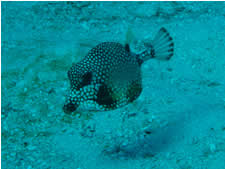 |
|
This smooth trunkfish is an odd-shaped boxy swimmer commonly seen on shallow reefs. It is related to the cowfish but lacks the horns over its eyes. Note the subtle honeycomb pattern on its side. (Photo by Cindy LaRosa) |
 |
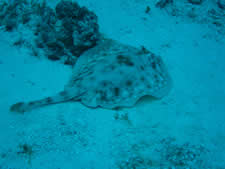 |
|
A yellow stingray has a rounded flounder-shape with numerous spots on it, unlike the plain but much more common southern stingray. It seemed relatively unafraid and did not flee when approached. Note the prominent poisonous spine on its tail. (Photo by Cindy LaRosa) |
 |
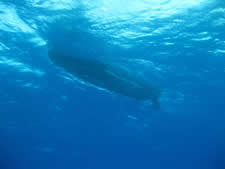 |
|
The dive boat waiting for the divers at the end of the second dive on Tuesday. Drift diving requires a "live" boat that is not anchored. Although divers are familiar with this view, it is an unusual perspective for non-divers. (Photo by Cindy LaRosa) |
 |
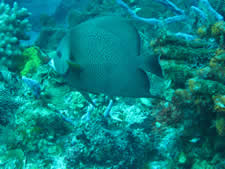 |
|
A gray angelfish is seen at Palancar Caves during the first dive on Wednesday, Dec. 14. (Photo by Cindy LaRosa) |
 |
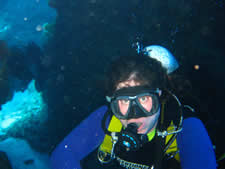 |
|
Kevin Magee inside a cavern at Palancar Caves. This site features a dramatic reef with lots of caverns, swim-throughs, towering coral pillars, and sand chutes leading to a deep wall. It is a lot of fun for divers with good buoyancy control and careful non-flutter fin kicks. (Photo by Cindy LaRosa) |
 |
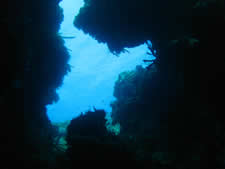 |
|
A view out through the opening of a cavern at Palancar Caves. (Photo by Cindy LaRosa) |
 |
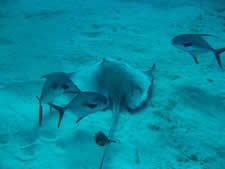 |
|
A southern stingray hunts for prey in the sand shallows. The horse-eye jack are shadowing above the ray to catch any creatures who suddenly burst from the sand and try to escape the ray. This is an example of cooperative hunting that is frequently seen between different underwater species. (Photo by Cindy LaRosa) |
 |
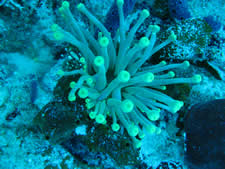 |
|
A colorful giant anemone is seen growing from a dark volcano sponge. (Photo by Cindy LaRosa) |
 |
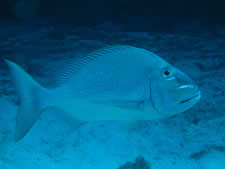 |
|
An uncommon and unusual-looking jolthead porgy swims past in the canyons of Palancar Caves. (Photo by Cindy LaRosa) |
 |
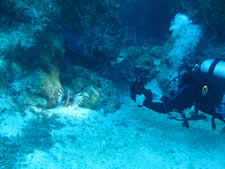 |
|
A lionfish is spotlighted and filmed by Mike, a Canadian videographer. Lionfish look pretty but have poisonous feathery spines. They are also an invasive species accidentally introduced from the Pacific/Red Sea who have taken over the Caribbean. Usually seen by the hundreds in other areas, only a few were seen in Cozumel due to aggressive hunting to keep them out of the park. As a result, they are wary of divers and are found mostly in less dove areas or deeper down the wall. (Photo by Cindy LaRosa) |
 |
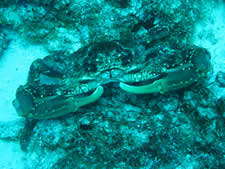 |
|
A large channel cling crab poses for the camera. (Photo by Cindy LaRosa) |
 |
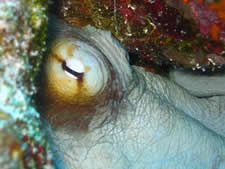 |
|
A caribbean reef octopus peers out of its hole during the second dive on Wednesday at French Point. Only the eye of the octopus was visible inside the small hole, and the octopus turned white when approached by the divers. (Photo by Cindy LaRosa) |
 |
